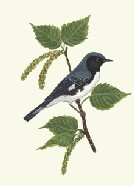by Cynthia Strain
Good binoculars make for good birding, while bad binoculars lead to missed birds, eye strain and headaches. A decent pair of binoculars for bird watching can be found for as low as $70.00 to $120.00. But you need to know what to look for.
Make sure the magnification is at least 7-power. A 7 x 35 pair of glasses will make objects appear 7 times as large as they actually are. Many people are tempted by 10 or 12 power binoculars, these are great, but unless you have a lot of experience with binoculars, these will cause you great difficulty locating the bird since they focus in on a smaller area. They also increase the effect of hand shake.
Make sure that the second number (35 for instance) is at least five times as large as the power, e.g. 8 x 40, unless you are buying compact binoculars. This second number describes the diameter, in millimeters, of the large lens in the front--the objective lens. The larger the lens, the greater the amount of light entering the binoculars, thus the better the image.
Are the binoculars too heavy for you to carry and use for at least 2 hours? Neck and back strain would surely detract from your enjoyment of the birds.
The barrels should be easily flexible, but not so flexible that they fall open when holding onto one side.
Coated lenses reduce internal glare and increase the amount of light. Hold the binoculars a foot away and look for a bluish or purple tinge to the lens.
You should be able to bring the barrels close enough together so that the images merge into one, single, clear image within a perfect circle, Improper binoculars can cause eye strain and headaches. If you wear glasses, make sure the rubber cups around the eyepieces fold back to accommodate eyeglasses.
Get binoculars that produce a clear image of an object as close as 20 feet,or you may miss some birds.
Look for minimal image distortion at the edges of the lens.
Chromatism is the rainbow-colored tinge around an object seen through a lens. Bad binoculars will create this effect, especially near the edge of the lens. Good binoculars will have very little chromatism.
When using binoculars, learn to look first for easily identifiable characteristics of the bird's immediate area in order to locate the bird. For instance, observe if the branch your bird is perched on is crooked, broken, short, or v-shaped. What is its location on the tree or in respect to its surroundings? These kinds of observations will greatly help you to then spot the bird through the binoculars.




